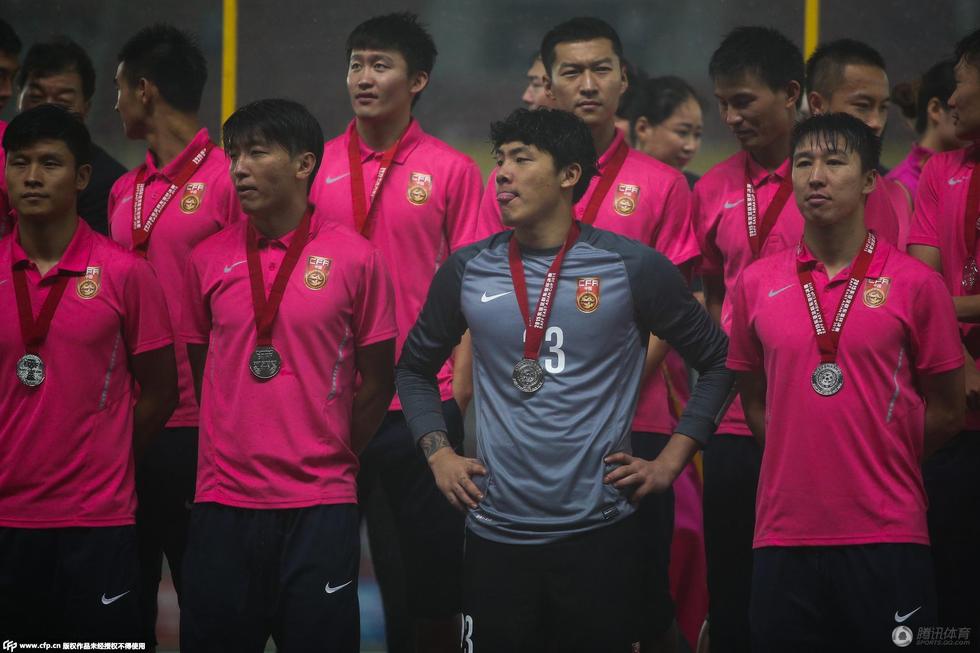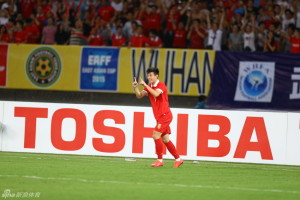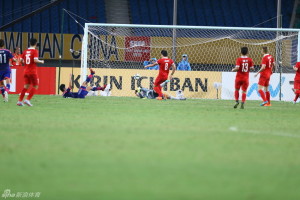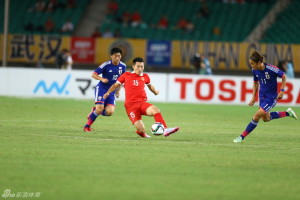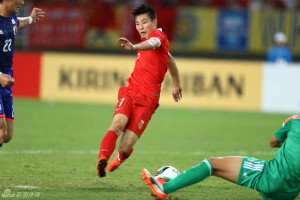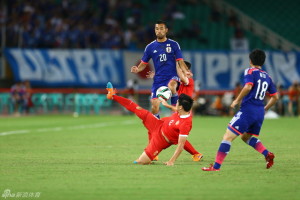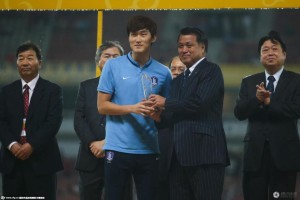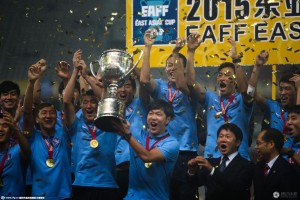China had to settle for second place in the East Asian Cup after an anti-climactic 1-1 draw with Japan. Following South Korea’s goalless stalemate with North Korea earlier in the evening, China could have lifted the trophy with a victory over the Japanese and things started well when Wu Lei put his team 1-0 up after just ten minutes. But Yuki Muto equalised four minutes before half time and China showed little sign of finding a winner in the second period.
East Asian Cup
China 1
Wu Lei 10′
Japan 1
Muto 41′
With a light rainfall and strong wind making the temperature in Wuhan significantly cooler than in recent days, the game started out at a more frantic pace than had been seen in any of the tournament’s previous five matches. And it was Japan, who had looked lethargic in their last two outings, that seemed to benefit from the more merciful conditions as they pinned China into their own third in the opening three minutes.
After defending a series of set pieces, China were able to break out in the 4th minute with the ball falling to Yu Dabao who fired a weak shot at Japanese goalkeeper Higashiguchi Maasaki from a difficult position. Within moments, though, Japan had another corner which resulted in Usami Takashi striking the underside of the bar with a 20-yard effort.
After weathering that early storm, China came back into the game with the attacking trio of Gao Lin, Yu Dabao and Wu Lei frequently switching positions and making life difficult for the Japanese defence. In the 8th minute, Gao was given a half chance when a tackle deflected to him off of Yu’s leg, but he swept just wide.
But the breakthrough came just two minutes later thanks to a neat move that stemmed from a throw-in. Ji Xiang tossed the ball to Yu who laid it back to Gao from the Japanese byline. Gao cut the ball across to Wu Xi who then prodded into the path of Wu Lei. The Shanghai SIPG attacker’s shot actually took a deflection off the hand of sprawling Japanese right back Niwa Daiki on the way in, but it was a suitable reward for a nice series of passes.
In the 22nd minute, Wu Lei hooked over from a difficult angle after using his pace down the left wing and exchanging a one-two with Wu Xi, but he really should have put China two up five minutes later. Left back Rao Weihui played an excellent long pass which put Wu in behind the Japanese defence but, with Japanese left back Koki Yonekura in hot pursuit, Wu ran the ball too close to Maasaki before stumbling as he tried to fire off a shot.
The officially announced 38,000 (probably about 5,000 less) in attendance shouted for a penalty, but replays made it clear that Wu’s muddled footwork was responsible for the tumble. In the 33rd minute, Yu Dabao was almost rewarded for a very hard working performance when he dispossessed Yonekura before cutting into the penalty area and squaring the ball to Rao Weihui. Rao’s effort was blocked, though, and things started to go downhill for the Chinese from that point on.
For all the danger posed by the Chinese attack, Japan continued to threaten down the left where right back Ji Xiang had a hard time dealing with winger Usamia Takashi and the overlapping Yonekura. Ren Hang had been forced to bail out his Jiangsu Sainty teammate with a last ditch tackle on more than one occasion and yet another break down the left resulted in a 40th minute corner for Japan.
Wang Dalei failed to get a touch on Yuki Muto’s delivery but, with the goalkeeper stranded, Japanese centre forward Kawamata Kengo was unable to keep his header from going over the bar.
That was a let off, but there was a growing sense that a Japanese goal was coming and it did barely a minute later. On another Japanese attack down the left, Ji Xiang followed Takashi inside allowing Yonekura to run onto a through ball in plenty of space. Wu Lei was tracking back, but he was unable to stop the Gamba Osaka player squaring to Muto who had slipped marker Cai Huikang in the middle. Cai did an excellent job of man-marking Muto throughout the game, but this one lapse was enough to let the Urawa Red Diamonds midfielder drive the ball home and become the tournament’s top scorer with two goals..
Aside from a Gao Lin booking, that was it for first half incident, but Japan started the second period much as they had the first as they pressed for a winner. In the 48th minute, Nagai Kensuke turned Rao Weihui before squaring for Hotaru Yamaguchi, only for the Cerezo Osaka midfielder to be denied a second long range goal of the tournament when his strike slammed into Ren Hang’s chest.
The rest of the second half largely followed the same pattern where Japan controlled possession and kept most of the play in the Chinese half without demonstrating much of a cutting edge. China’s attack, which had looked so menacing in the opening half hour, had clearly run out of steam and Yang Xu replacing Yu Dabao in the 63rd minute did little to revitalise it.
As the half wore on, China started to more closely resemble the side that fell apart against South Korea in the tournament opener but, although there were some absurd moments like experienced centre back Feng Xiaoting trying to carry the ball out of defence before running into a Japanese player and turning around to kick it out for a corner, things never quite got that bad.
Zheng Zhi replaced Wu Xi in the 69th minute in order to restore some order to the midfield, but that also left China with a remarkably slow central trio of Zheng, Liu Jianye and Cai Huikang. Within a minute of Zheng coming on, some composed passing at the back between Rao Weihui and Wang Dalei was immediately undone when Liu Jianye played a dangerous ball to Wu Lei who immediately conceded possession in his own half.
This forced Wang into making a fine close range from Muto and led to groans among those in attendance. In the 79th minute, a good through ball to Yang Xu from Gao Lin looked to have given China a chance, but centre back Makino Tomoaki produced a fine tackle to deny Yang before he could get his shot off.
Alain Perrin then added some pace to the attack when he brought on Zhang Chiming for Gao Lin, but China had no real chances after that as efforts to play more directly into Zhang and Yang Xu were hampered by a very strong head wind. Japan almost snatched the victory when substitute Gaku Shibasake squared to Yamaguchi who looked set to fire off a shot from the edge of the area. However, Cai Huikang was there to make a perfectly timed tackle, injuring his knee in the process, and the final ten minutes wound down with little sign of either side breaking the deadlock.
A Game of Three Thirds
With eight of the players dropped after the South Korea game back in the starting line-up, this looked much more like a Perrin team close to full strength. Only Yu Dabao, Liu Jianye and Rao Weihui survived from the North Korea match as China reverted from a back five to a back four.
Ostensibly, the favoured 4-2-3-1 was back with Gao Lin up top, Wu Lei on the right, Yu Dabao on the left and Wu Xi in the middle of the attacking midfield three. In practice, though, at least in the first half, the attack showed a lot more fluency than that with Gao, Wu Lei and Yu regularly switching places and the set-up looking more like 4-3-3 at times with Wu Xi, Liu Jianye and Cai Huikang making up the midfield three. Wu Lei popped up on both the right and left wings, while Yu would sometimes move into the middle, either pushing Gao wide or joining the Guangzhou Evergrande forward in the centre to create an unbalanced attack.
This tactic was very certainly effective in the opening 30 minutes or so and seemed to get the best out of all three forwards. Both Gao and Wu Lei did more in the first ten minutes than they had during the entirety of their time on the pitch against South Korea and Yu continued to make a strong argument for regular inclusion in Perrin’s starting eleven.
Wu Lei’s generally excellent first half included a goal, but it did also feature a wasted chance when clean through on goal that demonstrated that the 23-year-old is still far from being the finished article. Meanwhile, Gao showed that he’s far more useful in a flexible attack then he is when asked to hold up play as a lone forward like he was supposed to do against South Korea. Of course, this exciting attack only really lasted for one third of the game, but it demonstrates that if the right combination is found China have the potential to be dangerous going forward.
In the midfield, Wu Xi worked hard as always and assisted Wu Lei’s goal. But he was unable to compete with the Japanese midfield for the full 90 minutes and was withdrawn 20 minutes before the end.
Wu certainly wasn’t helped by being accompanied by Jiangsu Sainty teammate Liu Jianye who didn’t play terribly, but offered such little dynamism and mislaid enough passes that one wonders if there are not other, better options to play the role of shielding midfielder. Guangzhou Evergrande’s Huang Bowen, Beijing Guoan’s Piao Cheng and, based on this season’s performances, Shijiazhuang Ever Bright’s Li Chunyu all come to mind as potential alternatives.
Aside from the goal (and that’s obviously a big aside) Cai Huikang did an excellent job of neutralising Yuki Muto and made some crucial tackles and interceptions when China were on the back foot in the second half. After having a difficult time of it against South Korea, Cai’s performance demonstrated his worth to the national team against the right opposition.
Defensively, Ji Xiang had a first half shocker at right back and it’s hard to see him maintaining the position when Zhang Chengdong and Zhang Linpeng are available. Left back Rao Weihui did OK while winning only his third international cap, but the ease with which Nagai Kensuke breezed past him early in the second half is a worry.
Despite the occasional very sloppy pass, Feng Xiaoting looked far more assured than he did against South Korea, but it was Ren Hang who really stood out in the position. It was by no means a flawless display from the 25-year-old, but several last-ditch tackles, a series of crucial blocks and composed passing out of defence made this his best performance in the Chinese shirt and shows that Perrin is not completely insane for moving him into the centre from left back.
In the Chinese goal, Wang Dalei had some difficulty when coming out to claim balls in the first half, but he also made some fine saves that help him continue to justify his status as China’s number one.
Tournament Overview
While failure to win left the patriotic Wuhan crowd deflated, it would have been unjust for China to take the trophy ahead of a far superior South Korea side. A record of one win and two draws hardly suggests a domineering team but, just as they had in their 1-1 draw against Japan, South Korea had much the better of the 0-0 stalemate with their northern neighbours without being able to get the result.
A combination of heroic defending and fantastic goalkeeping from Ri Myong-guk kept the South Koreans at bay and rightly helped Ri win the goalkeeper of the tournament award. Although their diminutive forward Ri Hyok-chol never stopped running, North Korea just didn’t look like scoring against a well organised defence marshalled by Guangzhou Evergrande centre back Kim Young-gwon.
At a bizarre closing ceremony in which all four teams were made to line-up in the rain as though it were a school sports’ day, Kim was named defender of the tournament and Guangzhou R&F defensive midfielder Jang Hyun-soo was named the competition’s best player. As the only South Korean outfield player apart from Kim to start all three games, it could be argued that he won the award by default but, as the midfield pivot in a team that controlled possession in three consecutive matches while only conceding one goal, Jang was well worthy of the award.
Considering that the 23-year-old has only really played in that role for less than a year after starting his career as a centre back, it’s clear he has a bright future ahead of him as long as he avoids the injuries that have plagued him over the last two seasons. One wonders how long R&F will be able to keep hold of him.
All in all the final placings were probably about right with Japan only really looking like Japan in the second half of the China game, and they were punished accordingly by having to go up and collect fourth place medals in front of the 1,000 or so disapproving Chinese fans that remained in the stadium after the full time whistle. We can only hope that FIFA aren’t inspired by this model so we don’t have to countdown from Honduras collecting their 32nd place medals before seeing the winners lift the trophy.
It could be argued that North Korea deserved to place above China simply because they were the competition’s most committed team. But apart from the tactic of playing long balls up to Pak Hyon-il which worked so well again Japan in the opener, they didn’t really offer much else going forward and would likely have suffered less flattering results had it not been for the efforts of Ri Myong-guk in goal.
And so to China, who probably just about deserved to finish second, but never played particularly well apart from the first half hour against Japan. It needs to be remembered, of course, that this was a very inexperienced Japan side missing all of its European based players and China were only just about able to hang with them over the 90 minutes.
The 2-0 win over North Korea is not to be sniffed at, particularly considering that neither Japan nor South Korea were able to beat the tournament underdogs, and that game gave some inexperienced players a chance to get a run out with the national team.
But it was the first game which set the tone for the tournament and demonstrates that China still have a way to go before they are a top tier Asian nation. China were bossed by what was largely South Korea’s reserve team and that is the match that will likely linger in Perrin’s mind as he looks ahead to a World Cup qualifying campaign which resumes with a home game against Hong Kong on September 3rd.
